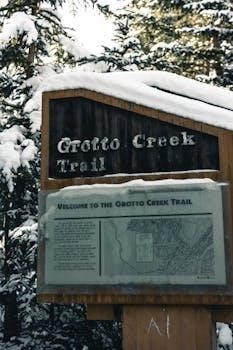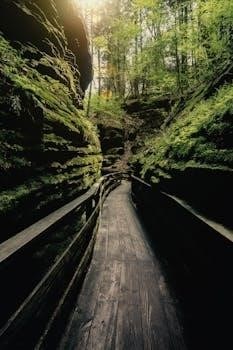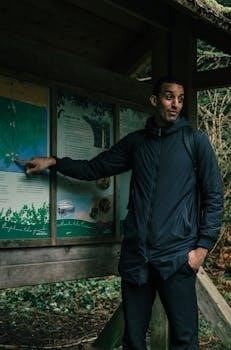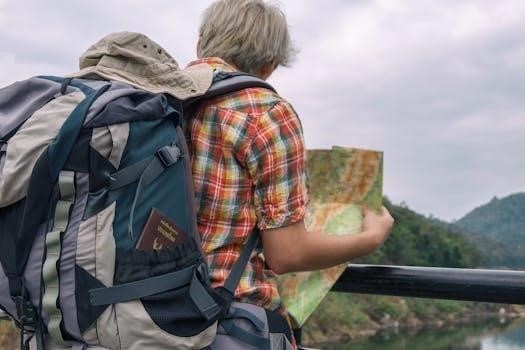Trans Wisconsin Adventure Trail Overview
The Trans Wisconsin Adventure Trail, a 600-mile route, spans from the Illinois border near Galena to Lake Superior. It traverses diverse landscapes, offering an unforgettable adventure through Wisconsin’s scenic beauty.
Route Length and Location
The trail stretches approximately 600 miles, beginning at the Illinois/Wisconsin border near Galena, Illinois, and concluding northeast of Cornucopia, Wisconsin, at the shores of Lake Superior. This extensive route crosses the entire state, offering a diverse range of scenery from rolling southern hills to the rugged northern terrain. Its geographical span makes it a significant adventure for travelers exploring Wisconsin.

Trail’s Acronym and Alternative Names
The trail is often referred to by the acronym “TWAT”. It is also commonly called the Trans Wisconsin Trail. These names are used interchangeably by enthusiasts.
Understanding the TWAT Acronym
The acronym “TWAT” for the Trans Wisconsin Adventure Trail has become a widely recognized, though sometimes controversial, nickname. While some find it humorous or catchy, others may prefer to use the full name or the alternative, “Trans Wisconsin Trail.” Understanding this acronym is crucial for navigating online discussions and forums about the route. It’s essential to be aware of this name, as it is common in the community.
Commonly Used Names for the Trail
While the official name is the “Trans Wisconsin Adventure Trail,” it’s frequently shortened to “Trans Wisconsin Trail” for simplicity. You’ll also encounter the acronym “TWAT,” which, as previously mentioned, is a common but sometimes contentious nickname. These various names are used interchangeably throughout forums, articles, and discussions about the route. Being familiar with all three terms is beneficial when researching or talking about it.
Trail’s Design and Intended Users
The trail was primarily designed for dual-sport and adventure motorcycles. However, high-clearance vehicles can also navigate it with some route modifications. This makes it accessible to a wider range of adventurers.
Designed for Dual Sport and Adventure Motorcycles
The Trans Wisconsin Adventure Trail, often referred to as the TWAT, was conceived with dual-sport and adventure motorcycles in mind. The route’s design incorporates a variety of surfaces and challenges suitable for these types of bikes, ensuring an exciting and engaging ride. Riders will encounter diverse terrains, from gravel roads to more technical ATV trails, making it a perfect fit for adventure-seeking motorcyclists.
Suitability for High Clearance Vehicles
While primarily designed for motorcycles, the Trans Wisconsin Adventure Trail is also accessible to high-clearance vehicles. However, some modifications to the route may be necessary to accommodate larger vehicles. Certain sections of the trail, particularly those involving ATV trails, may present challenges for vehicles without sufficient ground clearance. The trail’s augmented version, curated for 4×4/overland vehicles, provides an alternative option.
Navigating the Trail
Navigating the Trans Wisconsin Adventure Trail requires reliance on GPS data, as paper maps are not available. This necessitates the use of digital tools and careful planning.
Lack of Paper Maps
A key characteristic of the Trans Wisconsin Adventure Trail is the absence of readily available paper maps. Unlike traditional trails, this route relies entirely on digital navigation. This means that adventurers need to be equipped with GPS devices or smartphone applications capable of handling GPS data. This lack of physical maps underscores the importance of preparing digital resources before embarking on the journey, ensuring a smooth experience.
Reliance on GPS Data
Given the absence of paper maps for the Trans Wisconsin Adventure Trail, navigation depends heavily on GPS data. Riders and drivers must utilize GPS devices or smartphone apps to follow the route. This reliance emphasizes the necessity of downloading and properly loading the appropriate GPX files before starting the journey. This dependence highlights the importance of technology for successful navigation and exploration of the trail.
GPS Data and File Formats
The trail’s navigation relies on digital GPS data, primarily using GPX files; These files are crucial for loading the route onto GPS devices and software like Google Earth for tracking.
Importance of GPX Files
GPX files are essential for navigating the Trans Wisconsin Adventure Trail, as they contain the precise route data. Since paper maps are unavailable, these files enable users to import the trail into GPS devices or mapping software. This allows for accurate tracking and route following, which is critical given the varied and sometimes remote nature of the trail. The files are used by both motorcycles and high-clearance vehicles.
Using GPS Data with Google Earth
Google Earth serves as a valuable tool for visualizing the Trans Wisconsin Adventure Trail using GPS data. After downloading the GPX file, users can import it into Google Earth to view the route on a satellite map. This allows for a detailed understanding of the terrain, roads, and surrounding areas. It also offers the option to trace the route onto a map for offline use, aiding in planning and navigation.

Trail Sections and Terrain
The trail transitions from southern rolling hills to northern rugged terrain. Expect a variety of surfaces including gravel roads, ATV trails, and more remote pathways, offering a diverse experience.
From Southern Rolling Hills to Northern Rugged Terrain
The journey begins in the south with gentle, rolling hills, gradually transforming into the more challenging and rugged terrain of northern Wisconsin as you progress. This change in landscape provides a varied and engaging experience for adventurers. The transition presents a diverse set of challenges for both riders and drivers, creating a truly memorable adventure across the state, from start to finish.
Variety of Trail Types⁚ Gravel Roads, ATV Trails, Remote Trails
The trail encompasses a wide range of surfaces, from smooth gravel roads ideal for a comfortable cruise, to more challenging ATV trails that demand more technical skill. The route also includes remote trails, offering a sense of isolation and adventure. This mix of trail types ensures that adventurers encounter a diverse and exciting riding experience that keeps them engaged throughout the journey.
User Created Maps and Resources
Adventurers have created resources like the CalTopo map, enhancing the trail experience. These community efforts provide valuable tools for planning and navigation along the route.
CalTopo User Created Map
A user-generated map on CalTopo, identified as ID C1LD, offers a valuable resource for exploring the Trans Wisconsin Adventure Trail. This collaborative map allows users to research, plan, and share their routes, providing real-time data and customizable layers. It facilitates printing maps and recording tracks, making it a practical tool for navigating the diverse terrain of the trail, whether in the backcountry or closer to home.

Experiences and Forum Discussions
Users share experiences, camping tips, and insights on forum discussions about the trail. Debates exist regarding the preferred travel direction, north to south or south to north, and daily distance.
User Experiences and Camping
Many users have shared their personal experiences tackling the Trans Wisconsin Adventure Trail, often highlighting the diverse terrains and challenges encountered along the way. Camping is a popular option, with riders frequently seeking advice on suitable locations and the best practices for overnight stays during their journey. Forum discussions also reveal a strong sense of camaraderie among adventurers who have traversed this route, with many offering valuable tips and insights to those planning to embark on the trail.
North to South vs South to North Travel
Discussions often revolve around the preferred direction of travel on the trail, with adventurers debating the merits of going north to south versus south to north. Some prefer the gradual increase in difficulty when traveling south to north, while others appreciate the descending terrain and changing landscapes when traveling north to south. The choice ultimately depends on personal preference and the desired level of challenge, as well as the time of year.

Bicycle Route Option
A dedicated Trans-Wisconsin Adventure Bicycle Route exists, fulfilling a long-held dream of formalizing a bike-touring path. This provides an alternative for cyclists seeking adventure across the state.
Trans-Wisconsin Adventure Bicycle Route
The Trans-Wisconsin Adventure Bicycle Route is a project born from a desire to create a formalized cycling trail. Inspired by a previous 8-day bike tour, it aims to offer a unique experience for cyclists. This route provides an alternative to the motorized options, allowing riders to explore the state at a different pace. It caters to those seeking a challenging and rewarding bicycle adventure;
Additional Resources
Lone Wolf Expeditions offers an overland route for the trail, providing a curated experience. Their resources can help travelers plan their adventure, including GPS data and route details.
Lone Wolf Expeditions Overland Route
Lone Wolf Expeditions provides an augmented version of the trail, specifically designed for 4×4 and overland vehicles. This resource includes GPS data available through a Dropbox link on their website, offering a curated experience for those seeking adventure beyond the standard ATV route. Their work provides a valuable alternative for travelers looking for a suitable path for their high-clearance vehicles, enhancing the accessibility of the trail. This route offers a unique perspective, blending the original with enhanced features.
